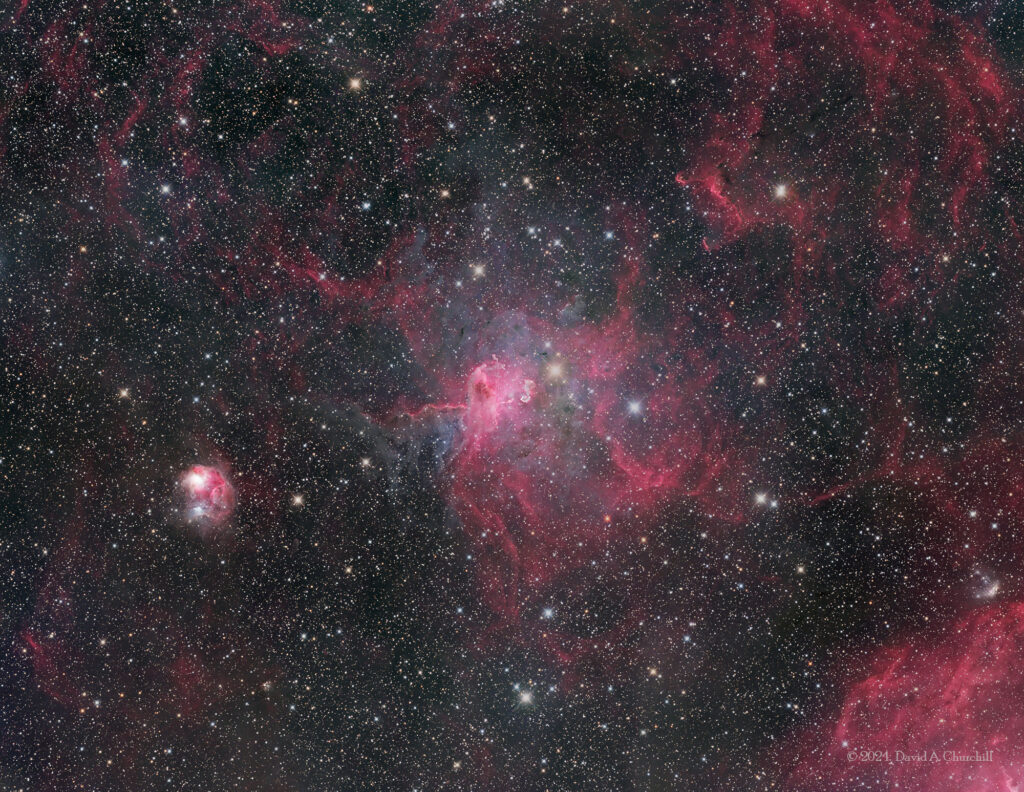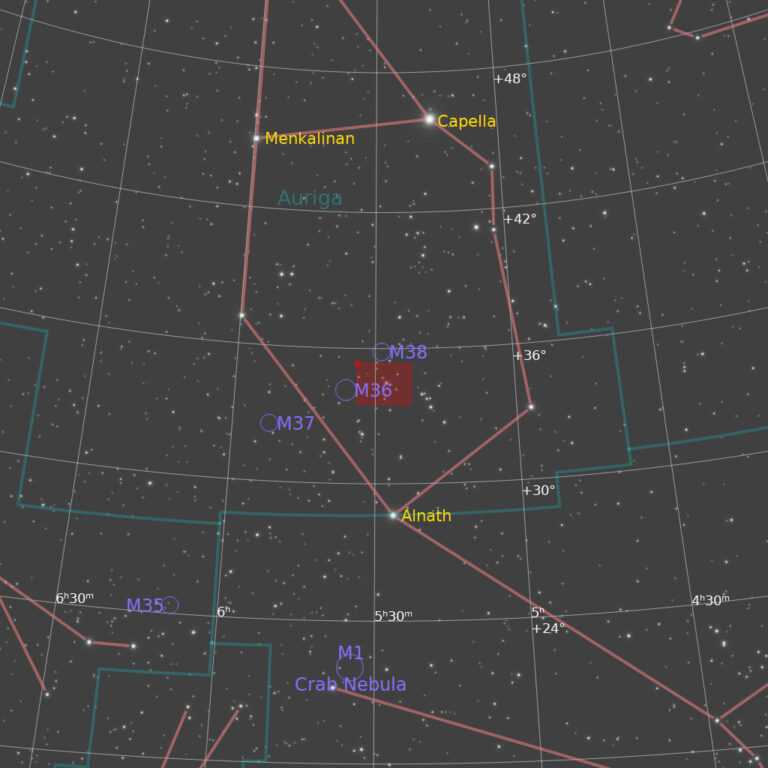IC 417
Spider Nebula. Emission Nebula, Auriga
January 2024. Cave Creek Canyon Observatory, Arizona Sky Village
- Description
- Technical
- Links
IC 417, sometimes known as the Spider Nebula, is a large emission nebula in the constellation Auriga. it is linked to the open cluster Stock 8 and is home to several important star formation processes. IC 417 is located in the south-central part of the constellation, in a region very rich in star fields and nebulae halfway between the stars ι Aurigae and θ Aurigae; in its immediate vicinity is the star φ Aurigae, which at magnitude 5.08 is a good reference. Through a telescope it is possible to distinguish the central open cluster, which is formed by a few dozen stars up to magnitude 12 and dominated towards the south by two stars of magnitude 9. The nebulous outline is best detected by long-exposure photographs. IC 417 is best observed between the months of October and March, and at northernmost latitudes it is circumpolar.
In the constellation Auriga, two large OB associations have traditionally been identified, lined up one behind the other. The first is indicated by the abbreviation Auriga OB1; Initially, twelve stars of spectral classes O and B were designated as effective members of the association, in addition to three red supergiants at the end of their life cycles. The suggested distance was about 1750 parsecs and was therefore placed on the Arm of Perseus. The second association is referred to as Auriga OB2 and was associated with eight stars of class O and B, mostly on the main sequence; its distance was indicated at least 6300 parsecs, i.e. in a remote area of the outer disk of the Milky Way. According to the most recent studies, however, the situation of OB associations in the direction of Auriga would seem to be more complex than initially believed: in fact, the two main associations identified would both be formed by the sum of two distinct stellar groups. Under the definition of Auriga OB1 there are two distinct associations located at 1100 and 2000 parsecs, respectively; Auriga OB2 includes two associations, the closest of which would be located at 3000 parsecs, while the most remote association is at about 6000 parsecs. IC 417 is located on the Perseus Arm in a region very rich in nebulosity, located however at various distances and visible here in succession one after the other; its most widely accepted distance is around 2300 parsecs (7500 light-years) or at most slightly less, around 2050 parsecs (6680 light-years), thus a short distance from the second Auriga subgroup OB1. This nebulous system is associated with several sources of infrared radiation, three of which are also catalogued by IRAS. The stellar components of the Stock 8 cluster have been studied at different wavelengths in order to determine the evolution of the region; In particular, it was discovered that the stars in the central cluster are between 1 and 5 million years old, indicating that star formation has taken place here on several occasions. To the east of Stock 8 there is a nebulous stream rich in young stellar objects, while about 13 parsecs from the cluster there is a second cluster of protostars deeply immersed in gas; the masses of these newly formed stars are between 0.1 and 3 M⊙. The western front of the stream is dominated by stars whose age is significantly younger than that of the stars in Stock 8.
In the constellation Auriga, two large OB associations have traditionally been identified, lined up one behind the other. The first is indicated by the abbreviation Auriga OB1; Initially, twelve stars of spectral classes O and B were designated as effective members of the association, in addition to three red supergiants at the end of their life cycles. The suggested distance was about 1750 parsecs and was therefore placed on the Arm of Perseus. The second association is referred to as Auriga OB2 and was associated with eight stars of class O and B, mostly on the main sequence; its distance was indicated at least 6300 parsecs, i.e. in a remote area of the outer disk of the Milky Way. According to the most recent studies, however, the situation of OB associations in the direction of Auriga would seem to be more complex than initially believed: in fact, the two main associations identified would both be formed by the sum of two distinct stellar groups. Under the definition of Auriga OB1 there are two distinct associations located at 1100 and 2000 parsecs, respectively; Auriga OB2 includes two associations, the closest of which would be located at 3000 parsecs, while the most remote association is at about 6000 parsecs. IC 417 is located on the Perseus Arm in a region very rich in nebulosity, located however at various distances and visible here in succession one after the other; its most widely accepted distance is around 2300 parsecs (7500 light-years) or at most slightly less, around 2050 parsecs (6680 light-years), thus a short distance from the second Auriga subgroup OB1. This nebulous system is associated with several sources of infrared radiation, three of which are also catalogued by IRAS. The stellar components of the Stock 8 cluster have been studied at different wavelengths in order to determine the evolution of the region; In particular, it was discovered that the stars in the central cluster are between 1 and 5 million years old, indicating that star formation has taken place here on several occasions. To the east of Stock 8 there is a nebulous stream rich in young stellar objects, while about 13 parsecs from the cluster there is a second cluster of protostars deeply immersed in gas; the masses of these newly formed stars are between 0.1 and 3 M⊙. The western front of the stream is dominated by stars whose age is significantly younger than that of the stars in Stock 8.
Telescope: Planewave Delta Rho 350 f3.0
Mount: Astro Physics 3600GTO “El Capitan”
Camera: ZWO ASI461MM pro / EFW-7
Guider: ZWO OAG-L-68 / ZWO ASI174mm Mini
Filters: Astrodon II 50mm Sq LRGB
L: 61×5 mins = 305 mins, R: 21×5 mins = 105 mins, G: 24×5 mins = 120 mins, B: 28×5 mins = 140 mins
Total Imaging Time: 11h 10m
Data Imaged remotely on 4 nights during December 2023 & January 2024.
Data acquisition & Processing by David Churchill.
None


